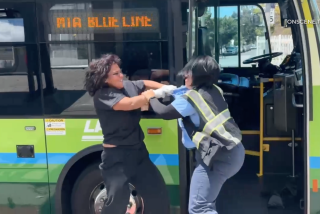Accident Left Her With Scars on Inside
- Share via
Sheila Styron was on a sidewalk in West Los Angeles when it happened. A bus, she says, angled in over the curb, and in one terrifying instant, caved in her upper front teeth, bruised her from head to shin and knocked her off her feet.
But that, she says, wasn’t the worst part.
Getting hit by a bus forced Sheila Styron to face two simple and profound facts about herself: She is blind and because she is blind she is vulnerable.
Those facts may seem obvious to anyone who does not rely on a guide dog to avoid banging into tables in restaurants or tripping over bumps in the sidewalk, but the truth is, until she was hit by a Santa Monica city bus in February, 1991, Sheila Styron--accomplished musician, singer and composer--never accepted that her life could be circumscribed by her inability to see.
And now she does.
“All my life before this happened to me, I really had made an incredibly major point of being Super Blind Person,” said Styron, 40. “ ‘I can do everything. Don’t patronize me.’ It was a real major part of who I was and how I kept my confidence and self-esteem up. No matter what, I wanted to maintain my independence.”
You could call it a form of denial. And it is. But when properly employed, denial can be a powerful and positive coping mechanism. According to a psychologist who will testify on her behalf in a lawsuit she has filed against the city of Santa Monica, denial is what kept Sheila Styron functioning so well for so many years.
And, he’ll maintain, it is what she was stripped of by the right front side of a 16-ton bus.
*
In settlement conferences, Santa Monica offered Styron $70,000, then $140,000. Styron’s attorney countered with a demand for $200,000. The city, however, withdrew its offer when the attorney for Santa Monica, Conrad Kohrs, found a bus passenger who will support the city’s version of events.
Said Styron’s attorney, Barry Novack: “There were five eyewitnesses who said Sheila was standing there and got hit by a moving bus. Now they have come up with a new witness who said the bus was stopped and Sheila walked into it.”
Kohrs said he will argue that Styron was at fault in the accident, that her injuries were minor and that she has suffered no lasting psychological damage. He will argue that she and her attorney are exaggerating the effects of the accident for monetary gain.
After many delays, the trial is slated to begin in October. Both sides will trot out their bus experts, their psychologists and their witnesses. A jury will decide whether Styron is entitled to damages and, if so, how much.
The case, which promises to be almost as bruising to Styron as the accident, got as far as jury selection in Superior Court in Santa Monica last month before being bumped for a criminal proceeding.
During pretrial motions, Kohrs asked the judge not to allow jurors to see Styron approach the witness box with Nicole, her yellow Labrador guide dog.
“There are obvious sympathy factors in this case,” Kohrs said. “A a blind, blond plaintiff and a blond dog that wags its tail.”
Styron, who was in the courtroom, was so offended by the motion that she had a hard time restraining herself. “I was trying not to scream,” she said. “This is my right! I am allowed to have this dog everywhere. In my opinion, the dog is not a sympathy factor, the dog makes me look independent and capable. That dog is my means to my dignity.”
The judge agreed that the jury would not be present when Styron approaches and leaves the witness box. But she agreed that Nicole could remain in the courtroom during the trial.
*
For the first year after the accident, Styron said, she rode buses like a madwoman.
“It was like, ‘Get back on that pony and ride.’ ” She almost never brought it up with friends because she was embarrassed. “I couldn’t believe this awful thing had happened to me, and I hate it when people feel sorry for me.”
The following year, Styron said, she slipped into a depression. “I started to just question the whole way I had done everything in my life as a blind person. I went from feeling confident about traveling on the buses to being at a party and feeling like I didn’t reach for a potato chip the same way as everyone else. I was just feeling very blind.”
Recently, she said, she has been feeling as though she is coming to some kind of accommodation between her denial and her feelings of vulnerability.
“Before, I didn’t like to deal with my blindness,” she said. “I brushed it away like a fly. Now, I am trying to put it into a healthy, moderated place in my life. Yes, some bad things have happened to me because of my blindness, and I have to talk about it with people, and it’s important for me to admit certain needs that I have.”
The psychologist who examined Styron for the city of Santa Monica suggested that she might benefit from “desensitization” sessions in which she is taught how to relax when she finds herself feeling anxious about a bus hitting her again.
“I don’t feel I will ever feel safe and secure about traveling,” Styron said. “I was doing nothing wrong and a bus hit me. How can desensitization training convince me that won’t happen again?”
And how can a woman who experienced sightlessness as a mere inconvenience for most of her life ever perceive it that way again?
More to Read
Sign up for Essential California
The most important California stories and recommendations in your inbox every morning.
You may occasionally receive promotional content from the Los Angeles Times.














